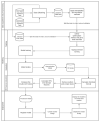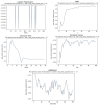HRV Monitoring Using Commercial Wearable Devices as a Health Indicator for Older Persons during the Pandemic
- PMID: 35271148
- PMCID: PMC8915092
- DOI: 10.3390/s22052001
HRV Monitoring Using Commercial Wearable Devices as a Health Indicator for Older Persons during the Pandemic
Abstract
Remote monitoring platforms based on advanced health sensors have the potential to become important tools during the COVID-19 pandemic, supporting the reduction in risks for affected populations such as the elderly. Current commercially available wearable devices still have limitations to deal with heart rate variability (HRV), an important health indicator of human aging. This study analyzes the role of a remote monitoring system designed to support health services to older people during the complete course of the COVID-19 pandemic in Brazil, since its beginning in Brazil in March 2020 until November 2021, based on HRV. Using different levels of analysis and data, we validated HRV parameters by comparing them with reference sensors and tools in HRV measurements. We compared the results obtained for the cardiac modulation data in time domain using samples of 10 elderly people's HRV data from Fitbit Inspire HR with the results provided by Kubios for the same population using a cardiac belt, with the data divided into train and test, where 75% of the data were used for training the models, with the remaining 25% as a test set for evaluating the final performance of the models. The results show that there is very little difference between the results obtained by the remote monitoring system compared with Kubios, indicating that the data obtained from these devices might provide accurate results in evaluating HRV in comparison with gold standard devices. We conclude that the application of the methods and techniques used and reported in this study are useful for the creation and validation of HRV indicators in time series obtained by means of wearable devices based on photoplethysmography sensors; therefore, they can be incorporated into remote monitoring processes as seen during the pandemic.
Keywords: heart rate variability; remote monitoring; wearables.
Conflict of interest statement
The authors declare no conflict of interest.
Figures


















References
-
- Pletscha A.H.M., Júnior A., Silveira N., Bittencourt W., Osórioe R. Analysis of Spectral Indexes of Variability of Cardiac Frequency during the Postural Change of Hypertensive Elderly. J. Health Sci. 2018;20:146-0.
-
- Marães V.R.F.S. Heart rate and its variability: Analysis and applications. Rev. Andal. Med. Deporte. 2010;3:33–42.
MeSH terms
LinkOut - more resources
Full Text Sources
Medical

